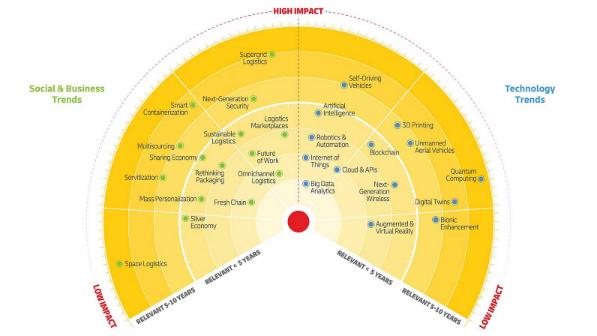
Innovation
The insights of today create the value of tomorrow
We believe logistics is entering a transformative decade and that trend foresight has never been more important. The DHL Logistics Trend Radar zeroes in on developments that will shape the future of logistics.
Tracking the trends and innovations that could impact your business
Looking back over the first two decades of the 21st century, we see a logistics industry reshaped by advancing technology, new business models, and dramatic shifts in customer behavior. In fact, the transformational nature of the past several years is perhaps greater than the past 100 years combined - and we're only beginning to feel the effects. From cloud computing to collaborative robots and big data analytics to artificial intelligence, how do we stay on top of the trends and make sense of wave after wave of disruptive technology?

The answer is by keeping them on our radar screens. To stay ahead and actively shape the coming transformation, logistics professionals need to continuously identify and embrace new trends. With this in mind, we collaborate closely with customers, analyze operations, and track technology to capture social, business and technology trends. The result is the DHL Logistics Trend Radar. Based on an extensive analysis of macro and micro trends, as well as the insights from over 20,000 logistics professionals and technology experts, the report is a dynamic and strategic foresight tool that tracks the evolution of trends spotted in past editions and identifies present and future trends with every update.

It is important to forecast the challenges ahead and envision possible solutions so that we may best advise our customers.
Katja Busch, Chief Commercial Officer, DHL
Will the next decade be even more transformational?
Now in its fifth edition, the DHL Logistics Trend Radar reveals 29 key trends that will impact the logistics industry. When we reflect on the past, present and future trends it becomes abundantly clear that logistics is entering a transformative decade.
The question is how transformative it will be. The data indicates that while the trends we have monitored over the past four years are stabilizing, the coronavirus pandemic has caused a seismic shift. Transformation processes are now in high gear as the logistics industry makes changes to weather the storm. Industry digitalization has been accelerated by years.
Increasing digital maturity allows us to focus on social and business trends that will shape the future of the logistics industry. Resilience, sustainability, and future-proofing the logistics workforce will take center stage on the strategic agendas of supply chain organizations in the years to come.
What about e-commerce?
The pandemic has also boosted e-commerce, which still only represents a fraction of global retail spending. The growth in this sector and its potential is going to continue to drive innovation and sustainability. Business-to-business e-commerce is expected to follow suit and dwarf the consumer market by a factor of three. Key digital moves to scale and adopt new technology will ultimately determine industry leadership positions in the future.
As efforts to cut carbon emissions and waste increase around the world, the trend toward sustainable logistics will remain at the top of supply chain agendas. There are huge opportunities to reduce the environmental footprint of logistics. By understanding the trends, we can work toward the solutions. For example, with more than 90 national bans on single-use plastics in force, rethinking how we package goods is inevitable. And with pollution increasingly taking center stage in today's congested cities, smart containerization and new last-mile solutions will give innovators a competitive edge.

The Logistics Trend Radar serves as seismograph for future trends. we already see the impact of COVID-19 is accelerating trends that were already well underway.
Matthias Heutger, Senior Vice President,
Global Head of Innovation & Commercial Development, DHL
Building resilient, sustainable, and future-proof supply chains
COVID-19 has been a catalyst for logistics innovation - and it has amplified three trends that have been shaping the industry for years.
#1
Managing risk with resilience
#2
Making logistics more sustainable
#3
Future-proofing supply chains
- Efficiency has long been the number one supply chain priority for most companies. Efforts to minimize overall cost have driven the development of low-cost sourcing strategies and just-in-time delivery in many industries. For the most part, these approaches have been extremely successful but recent events, from trade wars to the coronavirus, have brought their weaknesses into the spotlight. Leading companies are now building proactive risk management systems with a focus on digital tools and well-rehearsed mitigation strategies.
- If the coronavirus pandemic has a silver lining, it is the sudden and dramatic reduction in carbon emissions precipitated by the worldwide economic slowdown. Although this will not likely last, sustainability will remain a high priority in the logistics sector. Social and environmental commitments are taking center stage and go beyond greenhouse gas emissions. The impact of solid waste, especially plastics, is coming under increasing scrutiny. Innovators are investing in cleaner vehicle technologies and exploring ways to reduce waste material in packaging.
- The digital transformation was already well underway before the coronavirus crisis, but change has taken on a new urgency as leaders look for ways to protect their organizations from future disruptive events. As companies digitalize their processes, they are finding that increased transparency and flexibility fuels demand for further digitalization. But as digital approaches become increasingly central to supply chains and logistics processes, companies are realizing that they need to pay more attention to the human side of their activities. Digital systems need people to build, maintain, and improve them, and supply chain operations require close and continual collaboration between people and machines.
Want it Delivered?
Why go looking for the latest logistics stories and insights when you can have them delivered right to you?
Putting vision into practice
How does the logistics industry understand and see the potential of technological breakthroughs in ever- changing social and business landscapes? Since 2013 at our DHL Innovation Centers, we have developed and continually updated the Logistics Trend Radar to highlight upcoming trends that will cause a relevant impact on future logistics. Complementing classic research methodologies, our unique and integrated customer-centric innovation approach helps us to interpret, evaluate, and prepare for what is to come.
Our three Innovation Centers - located in Germany, Singapore, and the United States - form a nexus of inspiration, connection, and engagement for our customers, partners, and colleagues. These centers foster the exchange of perspectives and new ideas that drive logistics innovation.
In order to separate the important signals from background noise in today's dynamic world, we have maintained three key values in developing the Logistics Trend Radar: staying close to customers, to new technology, and to operations.
We collaborate closely with our customers around the world to understand pain points and unmet supply chain needs. We also engage supply chain leaders across all industries to paint a complete picture of the trends impacting the world's supply chains as well as those disproportionately affecting specific industries.
Between each edition of the Logistics Trend Radar, we work directly with hundreds of startups and monitor another 1,000 to keep pace with change and stay ahead of emerging technologies.
To better visualize solutions that can be leveraged to improve supply chain processes, we also spend a great deal of time on-site at our logistics facilities. By listening to the needs of management and staff and walking in their shoes, we remain deeply familiar with all aspects of our air, ocean, road, and rail operations and better able to understand the relevance of emerging trends and their impact on the industry.
This unique and integrated customer-centric approach to innovation complements our trend research and helps us to interpret, evaluate, and prepare for what is to come.
Published: October 2020






